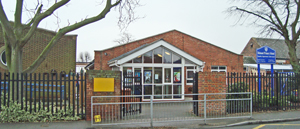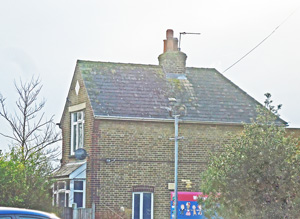The Sanatorium
Belmont Road, Little Heath, Belvedere, Kent DA8 1LE
Medical
dates:
Medical
character:
Infectious diseases
In December 1881 the Erith Urban
District Council proposed to build a 2-storey isolation hospital with 8
beds for patients with infectious diseases. A small plot of land
of just over an acre was purchased at Little Heath in 1882 for this
purpose, at a cost of £300. Located near the boundary of
the District, the site was truly isolated; there were no houses within
a quarter of a mile of it.
However, eleven years would pass before the hospital finally opened. In 1892 a temporary isolation hospital had to be hurriedly built in Long Lane, Bexleyheath.
The Erith Urban District Council Sanatorium for Infectious Diseases opened in July 1893 with 15 beds. It had cost about £2,000 to build and furnish.
At the beginning of the 20th century Walnut Tree House, a property in the centre of Erith owned by the Council, became an annexe for the Sanatorium to provide extra patient accommodation. Following improvements and extensions to the Sanatorium the annexe was vacated in 1902.
By this time the Sanatorium consisted of an administration block, a block with two wards of 4 beds each for diphtheria patients, and an iron building for scarlet fever patients; this contained two large wards of 8 beds each and a small 1-bedded ward. The beds were seldom all occupied. Patients with other infectious diseases, such as enteric fever and measles, would also be admitted, but smallpox cases were sent to the hospital ships moored at Long Reach.
Patients remained at the Sanatorium from 3 to 10 weeks. Patients were only allowed to visit their children at weekends; during the week they could only view them through the ward windows. During an outbreak of scarlet fever or diphtheria, schools would close for up to three or four weeks to prevent spread of infection.
In 1908 two acres of adjacent land were purchased so that the Sanatorium could be further enlarged. A new laundry was built and a Thresh steam disinfector installed on part of the land, opening in January 1911. (Prior to this, the disinfector had been of the hot air type.)
Building work continued and, by 1913, the iron ward block had been replaced by a brick building containing two wards with 14 beds each for scarlet fever patients. The iron building was not in use but was kept in reserve in case of an epidemic. Two ambulances to collect infected patients from their homes and a van (zinc-lined) for removal of infected bedding were kept on the site, but no horses; these were hired from a local contractor when the need arose.
The staff of the Sanatorium consisted of a Matron, 4 nurses, the necessary domestic staff, a laundress and a porter.
At the beginning of 1913 the Sanatorium had 15 patients - 7 with scarlet fever and 8 with diphtheria. During the year 105 were admitted with scarlet fever (one died) and 34 with diphtheria (one died). By the end of the year 26 patients remained - 22 with scarlet fever and 4 with diphtheria.
In 1915 the administration block was greatly enlarged; this provided much needed nurses' accommodation. A large block at some distance from this main building was built to accommodate diphtheria cases. It had two 6-bedded wards, as well as two small 1-bedded wards used for observation purposes. The old diphtheria wards with 8 beds were given over to scarlet fever patients.
By 1918, the Sanatorium had 50 beds. A brick block with two 4-bedded wards had been added, which could be used for other diseases or for observation cases. The site also contained the laundry and its drying room, the steam disinfector, the porter's lodge (housing the porter and his wife), the mortuary and the ambulance sheds. Only one ambulance, manned by the local firemen, was available by this time, but a wish was expressed to have a motorised vehicle (this was granted in 1920).
The Sanatorium was managed by a Medical Superintendent and a Matron, who was responsible for both nursing and domestic staff. The nursing staff consisted of a Sister and 4 nurses, but it was proving difficult to recruit staff because of the remoteness of the site.
A gardener attended to the vegetable plot, which supplied the Sanatorium with produce. On occasion, lucerne (alfalfa), a forage crop for cattle, was grown for local farmers, providing an income for the Urban District Council.
At the outbreak of WW2 in 1939 the Sanatorium joined the Emergency Medical Service with 56 beds. The diphtheria ward was requisitioned for use as an Air Raid Precautions (ARP) post (this later moved to Parsonage Manor farmhouse nearby, as the ward was required for an outbreak of diphtheria). During 1940 the mortuary was used also for civilians killed by a air raids.
On Thursday, 8th February 1945, a V2 rocket exploded in Langdale Crescent, a short distance away. Protected by the blast walls, no staff or patients were killed or injured, but the windows, doors and roofs suffered blast damage. It was decided not to evacuate the hospital as two wards were still usable; repair gangs were drafted in to do emergency work. However, in the following week, on Tuesday, 13th February, another V2 rocket landed in the grounds near the main buildings, causing widespread damage. Again, the blast walls had prevented a great number of casualties but widespread damage was inflicted on all the hospital buildings. Power lines had been destroyed, making the buildings uninhabitable.
Patients were transferred to Bow Arrow Hospital in Dartford or to the West Kent Isolation Hospital at Bromley Common. Staff were temporarily accommodated at the Ormonde House, a nursing home at No. 68 Picardy Road, Belvedere, and later transferred to Hainault Hospital in Erith or found other jobs elsewhere.
The Sanatorium never re-opened.
The buildings were demolished and Belmont Primary School built on its site, opening in 1951.
All that remains of the Sanatorium is the porter's lodge in Belmont Road and a block adjacent to Bedonwell Road.
However, eleven years would pass before the hospital finally opened. In 1892 a temporary isolation hospital had to be hurriedly built in Long Lane, Bexleyheath.
The Erith Urban District Council Sanatorium for Infectious Diseases opened in July 1893 with 15 beds. It had cost about £2,000 to build and furnish.
At the beginning of the 20th century Walnut Tree House, a property in the centre of Erith owned by the Council, became an annexe for the Sanatorium to provide extra patient accommodation. Following improvements and extensions to the Sanatorium the annexe was vacated in 1902.
By this time the Sanatorium consisted of an administration block, a block with two wards of 4 beds each for diphtheria patients, and an iron building for scarlet fever patients; this contained two large wards of 8 beds each and a small 1-bedded ward. The beds were seldom all occupied. Patients with other infectious diseases, such as enteric fever and measles, would also be admitted, but smallpox cases were sent to the hospital ships moored at Long Reach.
Patients remained at the Sanatorium from 3 to 10 weeks. Patients were only allowed to visit their children at weekends; during the week they could only view them through the ward windows. During an outbreak of scarlet fever or diphtheria, schools would close for up to three or four weeks to prevent spread of infection.
In 1908 two acres of adjacent land were purchased so that the Sanatorium could be further enlarged. A new laundry was built and a Thresh steam disinfector installed on part of the land, opening in January 1911. (Prior to this, the disinfector had been of the hot air type.)
Building work continued and, by 1913, the iron ward block had been replaced by a brick building containing two wards with 14 beds each for scarlet fever patients. The iron building was not in use but was kept in reserve in case of an epidemic. Two ambulances to collect infected patients from their homes and a van (zinc-lined) for removal of infected bedding were kept on the site, but no horses; these were hired from a local contractor when the need arose.
The staff of the Sanatorium consisted of a Matron, 4 nurses, the necessary domestic staff, a laundress and a porter.
At the beginning of 1913 the Sanatorium had 15 patients - 7 with scarlet fever and 8 with diphtheria. During the year 105 were admitted with scarlet fever (one died) and 34 with diphtheria (one died). By the end of the year 26 patients remained - 22 with scarlet fever and 4 with diphtheria.
In 1915 the administration block was greatly enlarged; this provided much needed nurses' accommodation. A large block at some distance from this main building was built to accommodate diphtheria cases. It had two 6-bedded wards, as well as two small 1-bedded wards used for observation purposes. The old diphtheria wards with 8 beds were given over to scarlet fever patients.
By 1918, the Sanatorium had 50 beds. A brick block with two 4-bedded wards had been added, which could be used for other diseases or for observation cases. The site also contained the laundry and its drying room, the steam disinfector, the porter's lodge (housing the porter and his wife), the mortuary and the ambulance sheds. Only one ambulance, manned by the local firemen, was available by this time, but a wish was expressed to have a motorised vehicle (this was granted in 1920).
The Sanatorium was managed by a Medical Superintendent and a Matron, who was responsible for both nursing and domestic staff. The nursing staff consisted of a Sister and 4 nurses, but it was proving difficult to recruit staff because of the remoteness of the site.
A gardener attended to the vegetable plot, which supplied the Sanatorium with produce. On occasion, lucerne (alfalfa), a forage crop for cattle, was grown for local farmers, providing an income for the Urban District Council.
At the outbreak of WW2 in 1939 the Sanatorium joined the Emergency Medical Service with 56 beds. The diphtheria ward was requisitioned for use as an Air Raid Precautions (ARP) post (this later moved to Parsonage Manor farmhouse nearby, as the ward was required for an outbreak of diphtheria). During 1940 the mortuary was used also for civilians killed by a air raids.
On Thursday, 8th February 1945, a V2 rocket exploded in Langdale Crescent, a short distance away. Protected by the blast walls, no staff or patients were killed or injured, but the windows, doors and roofs suffered blast damage. It was decided not to evacuate the hospital as two wards were still usable; repair gangs were drafted in to do emergency work. However, in the following week, on Tuesday, 13th February, another V2 rocket landed in the grounds near the main buildings, causing widespread damage. Again, the blast walls had prevented a great number of casualties but widespread damage was inflicted on all the hospital buildings. Power lines had been destroyed, making the buildings uninhabitable.
Patients were transferred to Bow Arrow Hospital in Dartford or to the West Kent Isolation Hospital at Bromley Common. Staff were temporarily accommodated at the Ormonde House, a nursing home at No. 68 Picardy Road, Belvedere, and later transferred to Hainault Hospital in Erith or found other jobs elsewhere.
The Sanatorium never re-opened.
Present status (February 2009)
After the war the war-damaged site was valued at £6,400 and sold for that amount in 1948 to the Kent Education Committee.The buildings were demolished and Belmont Primary School built on its site, opening in 1951.
All that remains of the Sanatorium is the porter's lodge in Belmont Road and a block adjacent to Bedonwell Road.

The School entrance on Bedonwell Road.

Belmont Primary School is located on the corner of Belmont and Bedonwell Roads.

The surviving ward block from the hospital era (above and below).


The porter's lodge to the Sanatorium.
Barnes LJJ 1915 Annual Report of the Medical Officer of Health. Urban District of Erith, 21-22.
Barnes LJJ 1918 Annual Report of the Medical Officer of Health. Urban District of Erith, 12.
Jerman AE 1908 Annual Report of the Medical Officer of Health. Urban District of Erith, 4.
Jerman AE 1913 Annual Report of the Medical Officer of Health. Urban District of Erith, 23-26.
Jerman AE 1919 Annual Report of the Medical Officer of Health. Urban District of Erith, 32.
Leader RA 1945 Annual Report of the Medical Officer of Health. Urban District of Erith, 19-20.
Tamsett T 2015 A Short History of Erith Sanatorium 1893-1945. Bexley Historical Society.
Return to home page